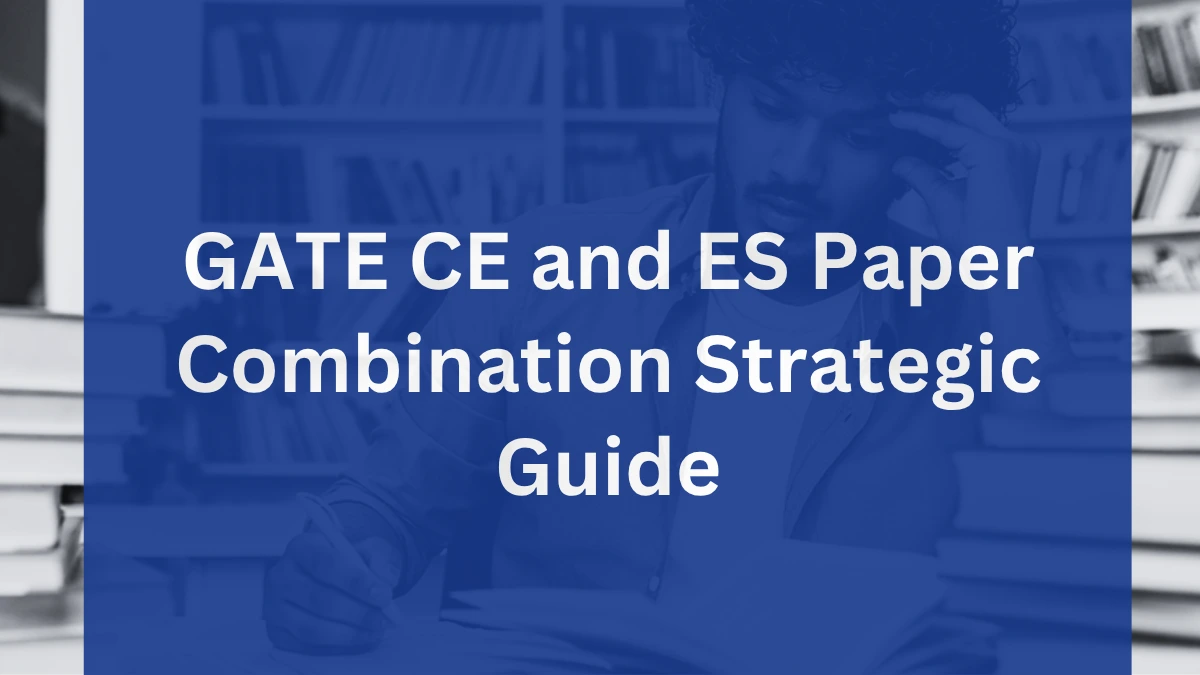GATE 2026 CE and ES Paper Combination Strategy
GATE 2026 CE and ES paper combination: For aspirants targeting the Graduate Aptitude Test in Engineering (GATE) 2026, choosing Civil Engineering (CE) as the primary paper and Environmental Science and Engineering (ES) as the secondary paper is a smart dual paper strategy. This GATE CE and ES paper combination offers significant syllabus overlap, aligns with high-demand job roles in PSUs and M.Tech programs, and maximizes the return on preparation time.

Why Choose GATE 2026 CE and ES paper combination?
Since GATE 2021, aspirants can opt for dual papers, provided the pairing is permitted. The GATE Civil + Environmental Science combination is ideal for civil engineering graduates because:
- There is considerable overlap in GATE CE and ES syllabus, especially in environmental engineering, fluid mechanics, and engineering mathematics.
- The pairing aligns with the growing career demand for sustainable infrastructure, environmental management, and climate-responsive design.
- It opens broader M.Tech and PSU recruitment avenues via dual GATE scores.
GATE CE and ES paper combination: GATE Syllabus for Civil Engineering (CE)
The GATE CE paper comprises General Aptitude (15 marks), Engineering Mathematics (10–13 marks), and Core Civil Engineering Subjects (72–75 marks). Below is the comprehensive syllabus, structured for clarity and aligned with the GATE 2026 framework (based on previous years, pending official release in August 2025).
| Section | Topics |
| General Aptitude | Verbal Ability: Grammar, vocabulary, sentence completion, critical reasoning, verbal analogies. Numerical Ability: Numerical computation, estimation, data interpretation, ratios, percentages, probability. |
| Engineering Mathematics | Linear Algebra: Matrices, determinants, systems of linear equations. Calculus: Limits, continuity, differentiation, integration, partial derivatives, maxima/minima. Differential Equations: First-order equations, higher-order linear equations with constant coefficients. Probability and Statistics: Mean, median, mode, standard deviation, probability distributions, hypothesis testing. Numerical Methods: Solutions to equations, numerical integration, interpolation. |
| Structural Engineering | Engineering Mechanics: Free-body diagrams, equilibrium, trusses, friction. Solid Mechanics: Stress and strain, Mohr’s circle, bending/shear stresses, deflection of beams. Structural Analysis: Statically determinate/indeterminate structures, influence lines, matrix methods. Construction Materials and Management: Concrete, steel properties, project planning, CPM, PERT. Concrete Structures: Design of beams, columns, slabs, prestressed concrete. Steel Structures: Design of tension/compression members, beams, plate girders, connections. |
| Geotechnical Engineering | Soil Mechanics: Soil properties, classification, permeability, seepage, consolidation, shear strength. Foundation Engineering: Shallow/deep foundations, bearing capacity, settlement, pile foundations, earth pressure theories. |
| Water Resources Engineering | Fluid Mechanics: Fluid properties, hydrostatics, Bernoulli’s equation, laminar/turbulent flow, pipe flow. Hydraulics: Open channel flow, hydraulic jump, flow measurement, pumps. Hydrology: Hydrologic cycle, precipitation, infiltration, runoff, hydrographs, flood estimation. Irrigation: Water requirements, canal design, gravity dams, spillways. |
| Environmental Engineering | Water and Wastewater Quality and Treatment: Water quality parameters, drinking water standards, coagulation, filtration, disinfection, wastewater treatment (primary, secondary, tertiary). Air Pollution: Sources, effects, control measures (e.g., ESP, scrubbers). Solid Waste Management: Collection, disposal, composting, landfill design. Noise Pollution: Sources, effects, control measures. Environmental Impact Assessment: EIA process, mitigation measures. |
| Transportation Engineering | Highway Planning: Geometric design, pavement materials, traffic studies. Traffic Engineering: Traffic flow, capacity, signal design. Railway and Airport Engineering: Runway design, railway track geometrics. |
| Geomatics Engineering | Surveying: Levelling, theodolite, triangulation, errors. Remote Sensing: Basics, photogrammetry, GIS applications. |
Read More: GATE CE Syllabus
GATE 2026 CE and ES paper combination: GATE Syllabus for Environmental Science and Engineering (ES)
The ES paper, introduced in 2021, includes General Aptitude (15 marks), Engineering Mathematics (10–13 marks), and Core ES Subjects (72–75 marks). It focuses on sustainability and environmental management, aligning with global trends. Below is the detailed syllabus.
| Section | Topics |
| General Aptitude | Verbal Ability: Grammar, vocabulary, sentence completion, critical reasoning, verbal analogies. Numerical Ability: Numerical computation, estimation, data interpretation, ratios, percentages, probability. |
| Engineering Mathematics | Linear Algebra: Matrices, determinants, systems of linear equations. Calculus: Limits, continuity, differentiation, integration, partial derivatives, maxima/minima. Differential Equations: First-order equations, higher-order linear equations with constant coefficients. Probability and Statistics: Mean, median, mode, standard deviation, probability distributions, hypothesis testing. Numerical Methods: Solutions to equations, numerical integration, environmental modeling. |
| Environmental Chemistry | Fundamentals: Atomic structure, chemical bonding, stoichiometry. Water Chemistry: Hardness, alkalinity, pH, chemical equilibrium. Atmospheric Chemistry: Photochemical reactions, ozone depletion, greenhouse gases. Soil Chemistry: Soil composition, ion exchange, organic matter. |
| Environmental Microbiology | Microorganisms: Types, growth, metabolism. Pollution Control: Biodegradation, bioremediation, activated sludge process. Pathogens: Waterborne diseases, microbial quality of water. |
| Water and Wastewater Treatment | Water Quality: Parameters (BOD, COD, DO), standards. Treatment Processes: Coagulation, flocculation, sedimentation, filtration, disinfection, advanced oxidation. Wastewater Treatment: Primary, secondary (activated sludge, trickling filters), tertiary treatment, sludge disposal. |
| Air and Noise Pollution | Air Pollution: Sources (stationary, mobile), pollutants (PM, SOx, NOx), control technologies (cyclones, scrubbers, ESP). Noise Pollution: Sources, measurement, health effects, control measures. |
| Solid and Hazardous Waste Management | Solid Waste: Types, collection, segregation, composting, incineration, landfill design. Hazardous Waste: Characteristics, handling, treatment, disposal (e.g., secure landfills). |
| Environmental Hydraulics | Flow in Pipes and Channels: Pipe networks, open channel flow, Darcy-Weisbach equation. Groundwater Flow: Darcy’s Law, aquifer properties, well hydraulics. Water Resource Management: Sustainable use, pollution in water bodies. |
| Ecology and Ecosystems | Ecosystems: Structure, function, energy flow, nutrient cycles. Biodiversity: Conservation, ecological succession. Environmental Interactions: Trophic levels, food webs, ecological pyramids. |
| Environmental Management and Sustainable Development | Environmental Impact Assessment: EIA process, baseline studies, mitigation. Sustainable Development: Principles, renewable energy, green technologies. Global Environmental Issues: Climate change, ozone depletion, international protocols (e.g., Kyoto, Montreal). |
Read More: GATE ES Syllabus
Syllabus Overlap Analysis- GATE CE and ES Combination
The CE and ES papers share substantial commonalities, enabling efficient GATE preparation. Below is a formal analysis of the overlapping topics:
1. General Aptitude
Commonality: Both papers allocate 15 marks to General Aptitude, covering verbal ability (grammar, sentence completion, analogies) and numerical ability (computation, data interpretation, probability).
Significance: Identical content allows candidates to prepare once for both papers, optimizing study time.
2. Engineering Mathematics
CE Syllabus: Linear algebra, calculus, differential equations, probability and statistics, numerical methods.
ES Syllabus: Linear algebra, calculus, differential equations, probability and statistics, numerical methods for environmental modeling.
Significance: The near-identical mathematical framework means CE preparation fully covers ES requirements, reducing additional effort.
3. Environmental Engineering
CE Syllabus: Water/wastewater treatment (coagulation, filtration, BOD/COD), air pollution (sources, control measures), solid waste management (landfills, composting), noise pollution, and EIA.
ES Syllabus: Water/wastewater treatment (identical processes), air/noise pollution (similar control technologies), solid/hazardous waste management, and EIA.
Significance: The environmental engineering section in CE aligns closely with ES’s core topics, enabling civil engineering candidates to leverage existing knowledge for ES preparation.
4. Fluid Mechanics and Hydraulics
CE Syllabus: Fluid mechanics (pipe flow, Bernoulli’s equation), hydraulics (open channel flow), hydrology (hydrologic cycle, runoff).
ES Syllabus: Environmental hydraulics (pipe/channel flow, Darcy’s Law), water resource management (pollution, groundwater).
Significance: CE’s fluid mechanics and hydrology provide a strong foundation for ES’s environmental hydraulics, particularly in pipe flow and groundwater concepts.
Key Differences Between CE and ES Papers
| GATE CE Only Topics | GATE ES Only Topics |
| Structural engineering | Environmental chemistry |
| Geotechnical engineering | Environmental microbiology |
| Transportation engineering | Ecology and biodiversity |
| Surveying & geomatics | Climate protocols, SDGs |
Understanding this difference helps in targeted preparation of ES-specific topics after completing CE.
Read More: GATE Exam Pattern
Benefits of Choosing GATE 2026 CE and ES Paper Combination
- Efficient GATE Preparation
- The overlap in General Aptitude, Engineering Mathematics, environmental engineering, and fluid mechanics/hydraulics minimizes additional study time for ES, making it an efficient choice for Civil Engineering GATE preparation.
- Enhanced Career Opportunities
- This combination prepares candidates for roles in civil engineering (e.g., infrastructure projects) and environmental engineering (e.g., water treatment, sustainability). PSUs like ONGC, NTPC, and BHEL prioritize candidates with expertise in sustainable infrastructure.
- Improved M.Tech Admission Prospects
- Dual scores in CE and ES increase chances of securing admission to top institutes like IIT Bombay or NIT Surathkal for M.Tech in Environmental Engineering. The ES score serves as a backup if the CE score is suboptimal.
- Alignment with Industry Trends
- Topics like EIA and sustainable development align with global demand for green technology and environmental management, positioning candidates for emerging roles.
- Advantage for Civil Engineering Candidates
- CE students’ familiarity with environmental engineering and fluid mechanics provides a head start in mastering ES topics, making it a less intensive secondary paper.
- Broader PSU Recruitment Opportunities
- Dual GATE scores qualify candidates for civil engineering roles at CPWD and environmental roles at Bharat Petroleum, enhancing PSU job prospects.
GATE 2026 Preparation Tips for CE + ES Combination
- Prioritize Overlapping Topics: Focus on CE’s environmental engineering, fluid mechanics, and mathematics, which cover ES requirements. Then, address ES-specific topics like environmental chemistry and ecology.
- Practice with Past Papers: Solve previous CE and ES papers and identify common question patterns.
- Mock Tests: Enrol in IMS Mock tests for both papers to enhance time management and exam readiness.
- Monitor Syllabus Updates: Check iitg.ac.in for the official GATE 2026 syllabus, expected in August 2025, to confirm any changes.
Read More: GATE Preparation
Comparison Table: GATE CE vs ES Paper – Overlap & Unique Topics
| Category | Civil Engineering (CE) | Environmental Science & Engineering (ES) | Overlap? |
| General Aptitude | Included (15 marks) | Included (15 marks) | Identical |
| Engineering Mathematics | Core topics like linear algebra, calculus, probability | Same topics with addition of environmental modeling | Major Overlap |
| Fluid Mechanics / Hydraulics | Pipe flow, open channel, hydrology | Environmental hydraulics, Darcy’s law | Strong Overlap |
| Environmental Engineering | Water/wastewater treatment, air/noise pollution, EIA | Same topics + hazardous waste | Strong Overlap |
| Structural Engineering | Beams, columns, prestressed concrete, steel design | Not included | CE-only |
| Geotechnical Engineering | Soil mechanics, foundations | Not included | CE-only |
| Transportation Engineering | Highways, railways, airport design | Not included | CE-only |
| Geomatics/Surveying | Levelling, GIS, remote sensing | Not included | CE-only |
| Environmental Chemistry | Briefly touched (water quality) | In-depth: atmospheric, soil, water chemistry | ES-only |
| Environmental Microbiology | Not covered | Key component (bioremediation, pathogens) | ES-only |
| Ecology & Sustainability | EIA only | Full topics on ecology, biodiversity, SDGs | ES-only |
| Global Environmental Issues | Limited (in EIA) | Detailed (Kyoto Protocol, Montreal Protocol) | ES-only |
GATE 2026 CE and ES Paper Combination- Conclusion
The CE and ES combination for GATE 2026 is a strategic choice for civil engineering candidates aiming to optimize their preparation and career prospects. The significant syllabus overlap in General Aptitude, Engineering Mathematics, environmental engineering, and fluid mechanics streamlines study efforts, while the combination aligns with industry demands for sustainable infrastructure and environmental management. By leveraging their CE foundation and supplementing it with ES-specific topics, candidates can achieve high scores, secure M.Tech admissions, and unlock diverse PSU job opportunities.
Read More: GATE Comprehensive Syllabus 2026
Frequently Asked Questions (FAQs) – GATE 2026 CE and ES Paper Combination
Is the CE and ES paper combination allowed in GATE 2026?
Yes, GATE permits a dual paper attempt, and the Civil Engineering (CE) and Environmental Science and Engineering (ES) pairing is officially approved. It’s a strategic combination for civil engineers due to syllabus overlap and career alignment.
What is the benefit of taking ES as the second paper for Civil Engineering in GATE 2026?
The GATE CE + ES paper combo enables you to reuse up to 70% of your CE preparation, especially in topics like environmental engineering, engineering mathematics, and fluid mechanics. It also opens doors for PSU jobs and M.Tech programs in both domains.
Do I need to study all ES topics separately if I’m a CE student?
Not entirely. Most ES topics in water treatment, air pollution, and hydraulics are already covered in CE. You’ll only need to focus on ES-specific topics like environmental chemistry, microbiology, and ecology.
Will having two GATE scores (CE and ES) improve my chances in PSU recruitment or M.Tech admissions?
Absolutely! Having valid scores in both CE and ES papers improves your shortlisting chances in IITs and NITs and expands your eligibility for multiple PSU roles, including those focused on sustainability and environmental projects.
What are the best strategies to prepare for GATE CE and ES together?
- Start with common topics: Aptitude, Maths, Environmental Engineering
- Practice GATE previous year questions from both papers
- Join a combined GATE test series
- Use short notes to revise ES-specific areas after CE is covered
- Track official updates from IIT Guwahati (IITG) for GATE 2026 syllabus releases







